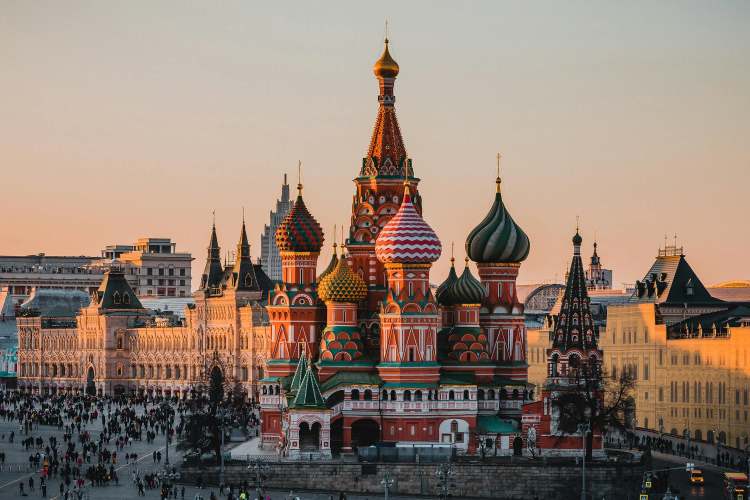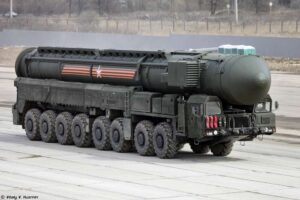
Russian President Vladimir Putin has redefined the rules for using his country’s nuclear arsenal, in a serious warning to the West. On 19 November, the Kremlin announced updates to Russia’s nuclear doctrine, lowering the threshold for deployment. The new policy permits nuclear strikes in response to attacks by non-nuclear nations supported by nuclear states — a notable shift from earlier guidelines that tied nuclear use to existential threats.
The timing of the announcement is no coincidence. It follows Ukraine’s first confirmed strike inside Russian territory using US-supplied ATACMS missiles, which hit a military facility in the Bryansk region. While Russian air defences intercepted most of the missiles, fragments caused a fire, though no casualties were reported. US officials confirmed the use of ATACMS, marking a new turn in Ukraine’s offensive capabilities.

Kremlin spokesperson Dmitry Peskov described the policy change as necessary to address “current political realities,” particularly the use of Western-supplied weapons against Russian targets. While Peskov emphasised that nuclear weapons remain a “last resort,” the updated doctrine indicates a more aggressive stance, treating attacks on Russia or its ally Belarus as potential triggers for a nuclear response.
This development is part of a broader strategy by Moscow to deter escalating Western support for Ukraine. Analysts suggest Putin is leveraging nuclear rhetoric to pressure the West into peace talks on Russia’s terms. “It is a calculated move to remind everyone of the stakes,” said Tatiana Stanovaya of the Carnegie Endowment for International Peace.
The Biden administration dismissed the Kremlin’s threats, labelling them as intimidation tactics. “The US and NATO pose no threat to Russia,” said State Department spokesperson Matt Miller. However, the updated doctrine has heightened global concerns, leaving the world on edge as Moscow raises the stakes in an increasingly volatile conflict.
READ I G20 Brazil: The last stand for the 1.5°C climate goal
Will Russia’s nuclear doctrine lead to an arms race?
Russia’s nuclear strategy has been undergoing significant changes as President Vladimir Putin reshapes the country’s military doctrine in response to escalating tensions with the West and setbacks in Ukraine. The recent updates to Russia’s nuclear posture, combined with large-scale exercises and accelerated modernisation efforts, signal a significant shift in its approach to nuclear deterrence. This reflects broader trends in global security, where traditional arms control frameworks are eroding, and the spectre of nuclear conflict looms larger than at any time since the Cold War.
Russia’s updated nuclear doctrine, as signalled by Putin, reflects a more assertive and expansive approach to nuclear force deployment. Previously, Moscow’s official stance limited the use of nuclear weapons to cases where the state faced existential threats. However, the revised policy permits nuclear strikes in response to significant conventional attacks by non-nuclear states that receive support from nuclear powers. This marks a fundamental shift, broadening the scenarios under which nuclear weapons could be employed.
Putin’s rhetoric during these updates has been unambiguous. He has repeatedly emphasised the need for a modern and operational nuclear force to counter what he describes as “emerging external threats.” These threats, according to Kremlin officials, emerged from NATO’s increasing involvement in Ukraine, particularly the provision of long-range weaponry capable of striking Russian territory. By lowering the threshold for nuclear use, Russia aims to deter both direct and indirect Western military actions in what it perceives as its sphere of influence.
This doctrinal shift aligns with calls from prominent figures in Moscow for a more aggressive stance. Sergey Karaganov, a leading Kremlin advisor, advocated for the potential early use of nuclear weapons in conflicts like Ukraine to secure Russian objectives and dissuade further Western intervention. Although Putin had publicly framed nuclear weapons as a “last resort,” his comments, in fact, suggested a willingness to adapt the doctrine further, if deemed necessary.
To highlight its nuclear readiness, Russia recently conducted an array of military exercises simulating large-scale retaliatory strikes. The October 29 drills were particularly significant, involving the launch of intercontinental ballistic missiles (ICBMs) from the Plesetsk spaceport, submarine-launched missiles from the Barents and Okhotsk Seas, and long-range cruise missiles from Tu-95 strategic bombers. Defense Minister Andrei Belousov clarified that the exercises were designed to simulate a coordinated nuclear counterattack in response to a hypothetical enemy strike.
These drills were not mere symbolic gestures. They demonstrated the continued upgrades to Russia’s nuclear arsenal, including enhanced precision, faster launch capabilities, and improved defences against interception. Putin’s personal oversight of the exercises sent a clear signal to NATO: Moscow views its nuclear forces as the cornerstone of its military strategy and a critical tool for deterring Western support for Ukraine.
Nuclear modernisation programme
Amid these doctrinal shifts, Russia is also nearing the completion of a decades-long nuclear modernisation programme. This effort, aimed at replacing Soviet-era systems with advanced capabilities, has brought nearly 95% of Russia’s nuclear triad — comprising land-based ICBMs, submarine-launched ballistic missiles (SLBMs), and air-launched systems — up to modern standards.
Estimates from the Federation of American Scientists suggest that Russia currently possesses approximately 4,380 nuclear warheads. Of these, 1,710 are deployed across land- and sea-based delivery systems, with additional warheads stored for potential use. This stockpile includes a substantial number of non-strategic nuclear warheads, which play a crucial role in Russia’s “escalate to deescalate” strategy—a doctrine that envisions the early use of low-yield nuclear weapons to halt adversarial advances in conventional conflicts.
Russia’s heavy reliance on its nuclear arsenal is driven by several factors. The depletion of its conventional forces in Ukraine has left Moscow more dependent on its strategic and tactical nuclear capabilities. Moreover, the modernisation programme seeks to maintain parity with the United States and compensate for perceived vulnerabilities, such as the growing sophistication of US missile defence systems. These efforts reveal the centrality of nuclear weapons in Russia’s national defence posture.
Erosion of arms control
The shifts in Russia’s nuclear strategy are occurring against the backdrop of a deteriorating global arms control landscape. The New START Treaty, the last remaining nuclear arms control agreement between the United States and Russia, is currently in a state of uncertainty. Russia suspended its participation in the treaty in early 2023, citing concerns about US inspections and NATO’s combined nuclear capabilities. While Moscow claims it remains within the treaty’s limits, the suspension undermines transparency and raises fears of an unchecked nuclear buildup.
This erosion of arms control agreements is not limited to Russia. The broader global situation has seen the dismantling of key frameworks, including the Intermediate-Range Nuclear Forces (INF) Treaty and the Open Skies Treaty. The absence of such important agreements has created a vacuum, allowing nuclear powers to enhance their arsenals and develop next-generation weapons with little oversight.
Russia’s withdrawal from the Comprehensive Nuclear Test Ban Treaty in 2023 shows this trend. Moscow justified the move by pointing to the lack of ratification by other nuclear powers, such as the United States and China. In September, Russian officials confirmed that the Novaya Zemlya test site was fully operational, signalling the potential resumption of nuclear testing—a move that would further destabilise the global arms control regime.
The shifts in Russia’s nuclear posture reflect a broader trend of nuclear rearmament among the world’s major powers. All nine nuclear-armed states are actively modernising their arsenals, with some developing more advanced and lethal systems. The United States, for instance, has invested heavily in its nuclear modernisation programme, a multibillion-dollar effort to upgrade its triad and develop next-generation weapons.
China, too, is expanding its nuclear capabilities, with projections suggesting it may double its warhead stockpile in the coming years. Meanwhile, emerging nuclear powers like North Korea continue to develop increasingly sophisticated delivery systems, raising regional and global security concerns.
The lack of meaningful dialogue among these powers has heightened the risk of miscalculation. As diplomatic caution gives way to open threats, the possibility of accidental or deliberate escalation becomes a pressing concern. UN Secretary-General António Guterres recently warned that the world faces an unprecedented risk of nuclear annihilation, highlighting the urgency of renewed arms control efforts.
Strategic implications of Russia’s posture
Russia’s evolving nuclear strategy has significant implications for global security. By lowering the threshold for nuclear use, Moscow increases the risk of escalation in conflicts like Ukraine. The expanded doctrine also complicates NATO’s strategic calculus, as any support for Ukraine could now be framed as justification for a Russian nuclear response.
Moreover, the modernisation of Russia’s nuclear forces enhances its ability to project power and deter adversaries. Advanced delivery systems with greater precision and faster launch capabilities reduce the margin for error, increasing the potential for rapid escalation. The deployment of tactical nuclear weapons in Belarus, a move intended to strengthen Moscow’s regional influence, further destabilises Eastern Europe.
The suspension of arms control agreements aggravates these risks. Without mechanisms like the New START Treaty, transparency is diminished, and both sides may feel compelled to expand their arsenals to maintain strategic parity. This dynamic fuels an arms race that threatens to undermine decades of progress toward disarmament.
The future of global nuclear security could take a more precarious turn with Donald Trump back in the White House. During his previous tenure, Trump dismantled several key arms control agreements, including the INF Treaty and the Open Skies Treaty, while signalling a willingness to embrace a renewed arms race. His administration also rejected the UN’s Treaty on the Prohibition of Nuclear Weapons and prioritised a $2 trillion nuclear modernisation programme. Experts fear that Trump’s potential policies, as outlined in conservative think tank manifestos like Project 2025, could accelerate the erosion of arms control by dismantling existing frameworks and encouraging global proliferation.
A Trump administration may embolden Russia’s aggressive nuclear posture, as Moscow could see an opportunity to expand its own arsenal without fear of US-led multilateral pushback. Also, Trump’s transactional approach to alliances and his criticism of NATO could weaken collective deterrence strategies, creating a more permissive environment for nuclear brinkmanship by states like Russia.
Such a dynamic could lead to increased instability, with both sides engaging in rapid nuclear buildups and lowering thresholds for use in regional conflicts. This trend highlights the critical need for leadership that prioritises arms control and de-escalation, rather than fuelling a competitive nuclear environment. With both Washington and Moscow adopting more aggressive postures, the likelihood of strategic miscalculations or deliberate escalation grows alarmingly higher, placing the world on a more dangerous track.
(The author, Director, Inter University Centre for Social Science Research and Extension (IUCSSRE), Mahatma Gandhi University (MGU), is Academic Advisor to the International Centre for Polar Studies (ICPS), MGU, Kerala, India. He was earlier Senior Professor of International Relations and Dean of Social Sciences at MGU.)
The author is ICSSR Senior Fellow and Director, Inter University Centre for Social Science Research and Extension (IUCSSRE), Mahatma Gandhi University, Kerala. He also served as Dean of Social Sciences and Professor of International Relations and Politics at Mahatma Gandhi University.

